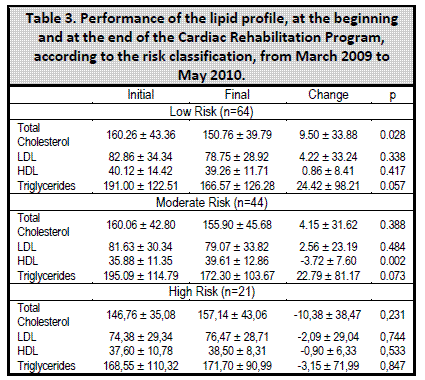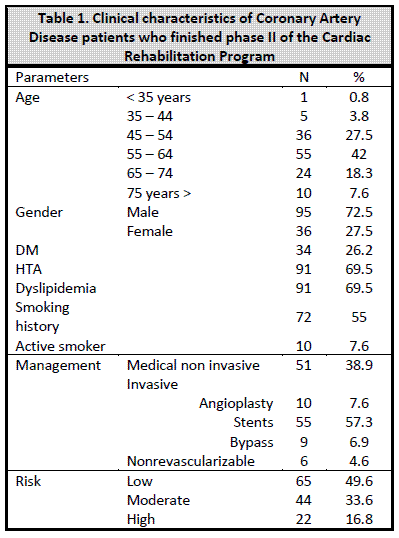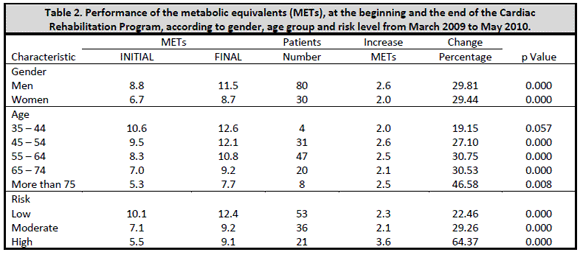Services on Demand
Journal
Article
Indicators
-
 Cited by SciELO
Cited by SciELO -
 Access statistics
Access statistics
Related links
-
 Similars in
SciELO
Similars in
SciELO
Share
Acta Médica Costarricense
On-line version ISSN 0001-6002Print version ISSN 0001-6012
Acta méd. costarric vol.53 n.4 San José Dec. 2011
Original
Results from the Phase II Cardiac Rehabilitation Program, developed by the National Rehabilitation Center, Costa Rica
(Resultados del Programa de Rehabilitación Cardíaca Fase II, desarrollado por el Centro Nacional de Rehabilitación, Costa Rica)
Manuel
Wong1, Miriam
García2,
Adriana García2,
Severita Carrillo1
Abstract
Objective: Due to the importance of cardiovascular disease in Costa Rica, and the lack of information about Cardiac Rehabilitation Programs in our country, this study aims to describe the results of the Phase II Cardiac Rehabilitation Program, at the National Rehabilitation Center.
Methods: This is a retrospective study, a review of the clinical records of patients with coronary artery disease, referred to a cardiac rehabilitation program from March 2009 to May 2010. From a total 158 patients, 131 finished phase II. Maximal functional capacity - estimated by a treadmill stress test - and the lipid profile were compared. These tests were made at the beginning and at the end of this phase II, which lasted 10-12 weeks.
Results: A significant statistical increase in the functional capacity was obtained, estimated in Metabolic Equivalents (METs), with a 29,7% average at the end of 10-12 weeks (p<0,05), evaluated with a treadmill stress test; higher (64,37%) for "High risk" patients and lower (19,15%) for younger patients. Total cholesterol decreased an of 4.44mg/dl (-2.9%) (p = 0.145), LDL-cholesterol decreased an average of 0.96 mg/dl (-1.1%) (p=0.746), triglycerides were 19.41mg/dl (-11.2%) (p=0.016) lower, and HDL-cholesterol increased an average of 0.95mg/dl (2.5%) (p= 0.181).
Conclusions: The program reported an average improvement in functional capacity of 29.7% for patients with coronary artery disease, with a higher impact for "High Risk" patients and a lower for younger patients. Lipid profile did not have significant changes at the end of this training period.
Keywords: exercise, registry, prognosis, coronary disease, lifestyle.
Cardiovascular disease is the worldwide leading cause of death, and generates important economic costs for healthcare systems. In Costa Rica, for the year 2008, 3813 deaths were reported from cardiovascular diseases. Most of deaths from cardiovascular diseases (55.65%) were people 75 years old or older. Males represented 57.09% of deaths; within these, 1529 were because of infarcts, corresponding to 40% of all deaths from cardiovascular diseases, with an adjusted rate of 29.42/100,000 inhabitants.1
This study aims to determine the results from the Phase II Cardiac Rehabilitation Program, from the National Rehabilitation Center (Centro Nacional de Rehabilitación, CENARE), concerning to the estimated functional capacity (expressed in Metabolic Equivalents, METs) and lipid profile, at the end of this 10-12 weeks training period. Besides, it is intended to inform the results, as there is so little published information about cardiac rehabilitation programs in our country.
Patients and methods
This study included patients admitted to phase II of the program between March 2009 and May 2010. The study group included patients with coronary artery disease, who underwent surgical procedures like coronary revascularization (angioplasty, coronary stenting or bypassing) and patients with medical management who did not underwent surgical procedures. A total of 158 patients with coronary artery disease participated. Patients with heart valve diseases, dilated cardiomyopathy and heart transplantation were excluded. From the starting 158 patients, 131 completed phase II.
Dropping out reasons were: 1 patient left for work reasons, 1 patient presented bacterial endocarditis, 1 patient because of prostate cancer, 1 patient due to colon cancer, 1 patient due to cerebrovascular disease sequelae, 1 patient because of presenting associated peripheral neuropathy, 1 patient for geographical reasons, 1 patient died from heart failure complications. For 8 patients, there was not obtained enough data from their files and 11 patients left the program with no reasons written on their files.
Based on criteria from the American Association of Cardiovascular and Pulmonary Rehabilitation (AACVPR),6 patients were classified into three risk groups: low, moderate and high risk. Resulting in: 65 low risk patients (49.6%), 44 moderate risk patients (33.6%) and 22 high risk patients (16.8%).
Results from stress tests were also recorded, with its estimated functional capacity (expressed in METs) and lipid profile.
As this is a review of clinical records, it was not considered necessary to obtain an informed consent. The National Rehabilitation Center´s Bioethical Committee supported the study before it was carried out.
The majority of referred patients had a previous treadmill stress test with a ramp protocol (Bruce or modified Bruce), performed by the referral cardiologist. If not, CENARE´s cardiologist performed this test with a ramp protocol (Bruce, modified Bruce or Naughton protocols). Ergospirometry was not performed because neither the referral hospitals nor CENARE had the equipment at the moment this study was made. Maximal oxygen consumption values (VO2max) were estimated in Metabolic Equivalents (METs) from the stress test, using formulas from the American College of Sports Medicine.7
The program consisted of 3 weekly aerobic training sessions, starting with 20 minutes each (at the beginning of the program) and up to 40 minutes (at the end of the program). The program lasted a total of 10-12 weeks. Each session started with a 10 minute warm up and stretching period and ended with a 5-10 minute cooling and stretching period.
Exercise modalities varied between: treadmill, stationary cycling, upper body ergometer, step aerobics and dancing. During exercise sessions, different modalities were combined, according to indications and contraindications established by biomechanical evaluations, for each patient. The aerobic exercise intensity started at 40-55% of the VO2max estimated from the initial stress test (equals to 50-65% of the maximum Heart Rate, HRmax), adherence level to physical activity and musculoskeletal comorbidities for each patient. So, for example, patients with low or none adherence to exercise history, started at 40% of the VO2max (50% of the HRmax), estimated from the first week of training. Exercise intensity was increased by 5-10% of the workload every 1-2 weeks (depending on the patients tolerance), and a sub-maximum exercise load was maintained. Patients were monitored with their heart rate, using a watch-like heart monitor (Polar brand), rate of perceived exertion (Borg Scale; numbered from 6 to 20)8; and telemetry for high risk patients, according to AACVPR classifications.
Besides participating in the physical training program, patients attended to educational speeches about cardiovascular disease, coronary risk factors, lifestyle changes and nutrition.
All the information gathered from patient files was analyzed with SPSS software, version 17.0 (Statistical Package for Social Sciences), with an α = 0.05 threshold value.
For all 131 patients who finished program phase II, a stratified analysis was perform, according to gender, age group and risk level. Mean initial AND final METs were compared for each stratus. For this, Student´s t-test for related samples was used.
An analysis was made, in which variables such as gender, age and risk were adjusted; and the METs percentage change was the dependent variable. For this, a multiple linear regression was made, as the resulting variable is a quantitative one. Conditions and hypothesis were tested, obtaining a low (0.289) and significant (0.001) correlation for gender and age.
Results
Clinical characteristics of the study patients
All patients who finished the program had coronary artery
disease. Their characteristics are summarized on Table 1.
Regarding the studied population´s clinical characteristics, 95 men (72.5%) and 36 women (27.5%) participated, with a mean of 59.1 + 10.1 years old. The 55 to 64 years-old age group turned to be the most frequent, gathering 42% of the patients.
Regarding the patient´s associated comorbity, 34 (26.2%) had type 2 Diabetes Mellitus; 91 (69.5%) hypertensive patients; 91 (69.5%) had dyslipidemia; 72 (55%) patients had a smoking history, from which 10 (7.6%) were still active smokers when they started the program.
From the 131 patients included, carriers of coronary artery disease, 51 (38.9%) had non-invasive medical management, 10 (7.6%) had an angioplasty, 55 (57.3%) had coronary stents and 9 (6.9%) had a coronary bypass surgery; 6 (4.6%) were referred to the cardiac rehabilitation program as nonrevascularizable coronary artery disease.
As seen on Table 2, there was a statistically significant increase in metabolic equivalents for all the analyzed groups, with important differences: High risk patients had the largest effect with a 64.37% increase and the lowest effect was seen for younger patients, with a 19.15% increase.
Data analysis shows that the risk significantly explains the 14% variation, for it is concluded that as there is a change from low to moderate risk, and from moderate to high risk, the METs percentage change is higher, its mean variation increases 25.96 points, adjusted for gender and age.
A lipid profile analysis was also performed at the end of the training period, showing a mean decrease for total cholesterol of 4.44 mg/dl (-2.9%) (p=0.145), for LDL cholesterol of 0.96 mg/dl (-1.1%) (p=0.746), for triglycerides of 19.41 mg/dl (-11.2) (p=0.016), and a rise in HDL cholesterol in 0.95 mg/dl (2.5%) (p=0.181). These findings were not statistically significant, excepting those for triglycerides; however this is not repeated once lipid profile changes are stratified according to their risk level, and do appear as significant changes for total cholesterol and HDL for low and moderate risks respectively.
Discussion
Regarding changes in lipid profiles, many other studies have reported changes after being subject to cardiac rehabilitation programs. 19,20 In this study just modest and non significant changes were found. These patients, in the majority of cases were already taking lipid-lowering drugs, and this was not taken into account, neither the fact that during this 10-12 week period they could have been subject to changes in their medication dosages by their physicians.
Concerning this aspects, there are possible explanations, such as:
Firstly, an inadequate caloric expenditure: a meta-analysis published in 2007 by Kodama21 reported statistically significant changes, even though those were modest changes (2.53 mg/dl [0.065 mmol/L]; P<0.001), with the minimal weekly volume to increase HDL levels estimated at 900 Kcal of caloric expenditure or 120 exercise-minutes a week; it is also indicated that, for each 10 minutes that an exercise session is extended, there is an approximate 1.4 mg/dl (0.036 mmol/L) increase in HDL levels and, however, there was not found any significant association between exercise frequency or intensity with the HDL change.
Secondly, in this study HDL nor LDL subfractions were not measured, from which there have been consequent changes described even with low intensity exercise (Kraus et al, 2002)22, producing larger and more HDL2 subfractions, with a higher anti-atherogenic potential, and producing larger and less atherogenic LDL.
As a third hypothesis, the lack of an adequate and individualized diet; even though patients received nutritional education, does not seem to be enough, because this speeches do not replace an adequate individualized diet for each patients preferences and eating habits. Besides, it should be considered that exercise increases appetite in most cases.

References
1. INEC -Unidad de Análisis Estadístico, Ministerio de Salud. Memoria Institucional 2008. En: http://www.ministeriodesalud.go.cr/sobre_ministerio/memorias/memoria2009/vlsituacion.pdf [ Links ]
2. Myers J, Prakash M, Froelicher V, Partington S, Atwood E. Exercise capacity and mortality among men referred for exercise testing. N Engl J Med. 2002; 346: 793-801 [ Links ]
3. Hammill B, Curtis L, Schulman K, Whellan D. Relationship Between Cardiac Rehabilitation and Long-Term Risks of Death and Myocardial Infarction Among Elderly Medicare Beneficiaries. Circulation 2010;121:63-70 [ Links ]
4. Leon A, Franklin B, Costa F, Balady G, Berra K, Stewart K, et al. Cardiac Rehabilitation and Secondary Prevention of Coronary Heart Disease.Circulation 2005;111:369-376. [ Links ]
5. Gotto A. Review of primary and secondary prevention trials with lovastatin, pravastatin, and simvastatin. Am J Cardiol 2005; 96:34F-38F [ Links ]
6. American Association of Cardiovascular and Pulmonary Rehabilitation. Guidelines for Cardiac Rehabilitation and Secondary Prevention Programs. Fourth Edition. USA: Human Kinetics. 2002 [ Links ]
7. ACSM’s REsourse Manuel for Guidelines for Exercise Testing and Prescription. American College of Sports Medicine. Fifth Edition. Baltimore. USA 2006. [ Links ]
8. Lee I, Sesso H, Oguma Y, Paffenbarger R. Relative Intensity of Physical Activity and Risk of Coronary Heart Disease. Circulation 2003; 107: 1110-1116 [ Links ]
9. Roselló M, Guzman S, Bolaños M. Efecto de un programa de rehabilitación cardíaca en la alimentación, peso corporal, perfil lipídico y ejercicio físico de pacientes con enfermedad coronaria. Rev Costarric Cardiol 2001; 3: 15-20. [ Links ]
10. Ades P, Savage P, Brawner C, Lyon C, Ehrman J, Bunn J, et al. Aerobic Capacity in Patients Entering Cardiac Rehabilitation. Circulation 2006;113: 2706-2712. [ Links ]
11. Belardinelli R, Paolini I, Cianci G, Piva P, Georgiou D, Purcaro A. Exercise training intervention after coronary angioplasty: the ETICA trial. J Am CollCardiol 2001;37:1891-1900. [ Links ]
12. Cheuk-Man Yu, Sheung-Wai Li, Chu-Pak Lau. Long – Term Changes in Exercise Capacity, Quality of life, body Anthropometry, and Lipid Profiles after a Cardiac Rehabilitation Program in Obese Patients with Coronary Heart Disease. Am J Cardiol 2003; 91: 321-325. [ Links ]
13. Savage P, Brochu M, Pochlman E, Ades P, Burlington V. Reduction in Obesity and Coronary risk factors after high caloric training in overweight coronary patients. Am Heart J 2003;146: 317-23. [ Links ]
14. Myers J. Exercise and Fitness. In: Cardiovascular Prevention and Rehabilitation. Springer. London, 2007: 77-87 [ Links ]
15. Serratosa F. Adaptaciones cardiacas al ejercicio. En: Fisiología del ejercicio. 3ra edición.Madrid: Panamericana 2006:321-356 [ Links ]
16. Hamburg N, Balady G. Exercise Rehabilitation in Peripheral Artery Disease: Functional Impact and Mechanism of Benefits. Circulation 2011; 123; 87-97 [ Links ]
17. Williams M, Haskell W, Ades P, Amsterdan E, Bittner V, Franklin B, et al. Resistance Exercise in Individuals With and Without Cardiovascular Disease: 2007 Update: A Scientific Statement from the American Heart Association Council on Clinical Cardiology and Council on Nutrition, Physical Activity, and Metabolism.Circulation. 2007;116:572-84. [ Links ]
18. American Association of Cardiovascular and Pulmonary Rehabilitation. AACVPR Cardiac Rehabilitation Resource Manual.Human Kinetics. USA. 2006. [ Links ]
19. Sarrafzadegan N. Changes in lipid profile of patients referred to a cardiac rehabilitation program. Eur J Cardiovasc Prev Rehabil 2008; 15: 467-72 [ Links ]
20. Toufan M, Pak J. Benefits of cardiac rehabilitation on lipid profile in patients with coronary artery disease. BiolSci 2009; 12: 1307-13 [ Links ]
21. Kodama S. Arch Intern MedEffect of aerobic exercise training on serum levels of high-density lipoprotein cholesterol: a metaanalysis.2007; 167: 999-1008. [ Links ]
22. Kraus W, Houmard J, Duscha B, Knetzger K, Wharton M, McCartney JS, et al. Effects of the Amount and Intensity of exercise on Plasma Lipoproteins. N Engl J Med 2002; 347:1483-1492. [ Links ]
23. Balady G, Arena R, Sietsema K, Myers J, Coke L, Fletcher G, et al. Clinician’s Guide to Cardiopulmonary Exercise Testing in Adults: A Scientific Statement From the American Heart Association. Circulation 2010; 122: 191-225 [ Links ]
1 Physical Medicine and Rehabilitation Specialist. Cardiac
Rehabilitation Department. National Rehabilitation Center "Humberto
Araya Rojas".
2 General Physician. Cardiac Rehabilitation Department. National Rehabilitation Center "Humberto Araya Rojas".
*Correspondence: National Rehabilitation Center
E-mail: manuwong@gmail.com











 text in
text in 




